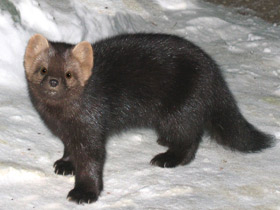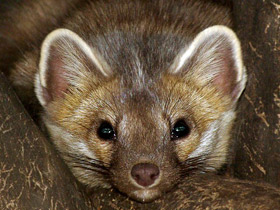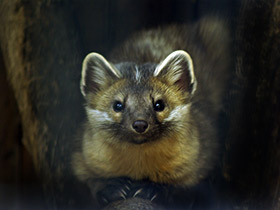The sable (Martes zibellina)
The sable (Martes zibellina) is a species of marten, a small omnivorous mammal primarily inhabiting the forest environments of Russia, from the Ural Mountains throughout Siberia, and northern Mongolia. Its habitat also borders eastern Kazakhstan, China, North Korea and Hokkaido, Japan.
The name "sable" originates from Slavic languages and entered Western European languages through the medieval fur trade. Sables are small, omnivorous mammals that inhabit dense forests in regions like Russia, Mongolia, and China. They are known for their luxurious fur, which ranges from light to dark brown and is softer and silkier than that of American martens. Sables resemble pine martens in size and appearance but have more elongated heads, longer ears, and shorter tails. They are skilled climbers and primarily hunt by sound and scent. Mating occurs between June and August, and litters typically have two or three offspring. Sable fur has been highly valued in the fur trade since the early Middle Ages, and its popularity has driven hunting and conservation efforts. Today, sable fur is often used to decorate clothing items, and the species has no special conservation status according to the IUCN Red List.
Description and habitat
Martes zibellina is a small mammal of the mustelidae family.
This small beast belongs to the most valuable fur-bearing animals and occupies a prominent place in the commercial fauna of Russia. Its average body length is about 50 cm and its weight is 1-1.5 kg. The main habitat of the marten is deep, dark taiga, dominated by cedar, spruce and pine; it is also found in taiga-type mountain forests. This predator is sedentary, staying in a particular individual area, which it will only leave in extreme cases: in case of forest fires, intensive logging or food shortage.
The Martes zibellina is an agile predator and very strong for its size. It has broad feet, whose soles are densely covered with stiff hairs (especially in winter), and can easily walk on loose snow. If necessary, Martes zibellina can dive into the snow and move through its thickness. Martes zibellina spends most of its time on the ground and is good at climbing trees, but rarely climbs into the canopy.
This small carnivore usually jumps from 30 to 70 cm in length. The marten is most active in the morning and evening. Its eyesight and posture are poor during the day, but it is very agile at night.
Nutrition
When hunting, Martes zibellina often scours every fallen tree trunk in its path, examining twisted roots, snags, debris and potholes, where it finds rodent burrows, which are its main food. In addition, Martes zibellina is interested in various land birds (grouse, capercaillie and capercaillie) and mammals (squirrels, chipmunks, hares and pikes), as well as lizards, frogs, insects, molluscs and even carrion. In summer, Martes zibellina enjoys eating various berries (blueberries, rowan, bird cherry and rose hips). Pine nuts play an important role in the diet of Martes zibellina. After finding a squirrel with a stock of nuts in winter, the marten eats its host and its food.
Reproduction
Martes zibellina breed in spring. They make their nests to spawn in hollows of fallen trees, in old stumps, in cavities between stony placers and sometimes in earth burrows. The bottom of the shelter is lined with moss, dry leaves and wool. In April-May the female Martes zibellina gives birth to 2 to 7 young, blind and whitish, which turn dark in a few days. The young grow rapidly and are visible within a month. The mother first feeds the young Martes zibellina with milk, then brings them small animals and birds, and takes the older ones with her so that they can get used to foraging. Martes zibellina cubs are very graceful in their movements, frolic like kittens and purr loudly in a fight. At two months of age, they switch to adult food. In August and September, the offspring are separated and the young Martes zibellina move on to an independent life.
Particularities
The Martes zibellina has a magnificent coat, which is always highly prized. Its colouring depends on the climatic conditions of the different habitats and is subject to fluctuations. The best Martes zibellina, with a dark, silky coat, is found in Central Siberia, Transbaikalia and Ussuriyskiy Krai. In the distant past, the Martes zibellina inhabited the entire taiga of Tsarist Russia and was the treasure trove of gold, but then, due to predation, populations of Martes zibellina declined catastrophically and it was threatened with total extinction in the wild. During the first years of Soviet rule, some effective measures were taken to restore the population of this valuable fur-bearing animal. In 1929, the first Martes zibellina cubs were obtained at the Moscow Zoo and, after the conditions for their care and maintenance were scientifically developed, they were bred on fur farms, which led to the development of Martes zibellina into an industrial fur farm. Martes zibellina have also been released in suitable areas in Siberia, Transbaikalia and the Far East, where they have become well established. Their numbers have increased so much that in many places they are larger than they were 100 years ago. Temporary hunting bans and the creation of state reserves of Martes zibellina have played an important role. The Barguzin and Kondo-Sosva nature reserves, as well as other institutions, have done much to restore the Martes zibellina. In captivity, Martes zibellina live between 15 and 18 years.


















































